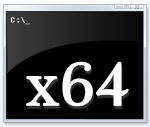26 May 2020 | Computers, Programming |
 ImageMagick is great. It allows your web app to process, resize, filter, and do all kinds of other nifty things with images.
ImageMagick is great. It allows your web app to process, resize, filter, and do all kinds of other nifty things with images.
Not so long ago, ImageMagick 7 was released. One of the big new features was full support for WEBP images, the new image format from Google.
Now, you might think it’s easy to just upgrade to ImageMagick 7. If you’re using a linux OS like Ubuntu, you just apt install and you’re done, right?
Well, no…
(more…)
2 January 2013 | Programming |
 Oopsy!
Oopsy!
On 25 December 2012, Ruby version 1.9.3-p362 was released. Is that dedication, or what?
Yesterday, I decided to upgrade to this new version of Ruby that contains only bug fixes.
Bad idea.
Sure, the site loads… But if you try to create a new record via the front-end UI, it craps out with an Internal Server Error.
Digging a bit deeper, it seems this new Ruby version causes a “stack level too deep” error in /active_record/transactions.rb – at least when using Rails 2.3.x.
So, how do we fix this little problem?
(more…)
7 February 2012 | Programming |
 If you’re like me, you still have some Rails 2.3.x apps hanging around. Yeah, Rails 3 is awesome in some respects, but that “2x performance increase” never quite materialized.
If you’re like me, you still have some Rails 2.3.x apps hanging around. Yeah, Rails 3 is awesome in some respects, but that “2x performance increase” never quite materialized.
In fact, for the most part, Rails 3 is still slower than Rails 2.3. SIGH!
Nevertheless, Ruby itself is progressing nicely. Ruby 1.9.3-p0 was released a few months ago. With faster garbage collection, startup, and file load times, Ruby 1.9.3 is where it’s at.
The only question is: What do you do to make Rails 2.3 play nicely with Ruby 1.9.3?
It’s actually not that hard!
(more…)
23 July 2011 | Programming |
 Let’s say you were using Rails 2.3.x, and you made the (wise) decision to implement heavy fragment caching. Then let’s say that you updated to Rails 3.x. At that point, you probably noticed that Rails 3 does something seriously annoying with the paths where it caches fragments.
Let’s say you were using Rails 2.3.x, and you made the (wise) decision to implement heavy fragment caching. Then let’s say that you updated to Rails 3.x. At that point, you probably noticed that Rails 3 does something seriously annoying with the paths where it caches fragments.
In Rails 2, doing this:
<% cache('posts/123/123456/main') do %>
Gave you a cache file that looks like this:
RAILS_ROOT/tmp/cache/views/posts/123/123456/main.cache
However, in Rails 3, the same cache code results in a cache file that looks like this:
RAILS_ROOT/tmp/cache/925/AB2/posts%2F123%2F123456%2Fmain
WTH? That’s not documented in the Rails 3 API. So what’s going on, and how do you make Rails 3’s fragment caching work like it used to instead of using those crazy hash subdirectories? Read on!
(more…)
16 December 2010 | Programming |
 If you’re like me, you’ve got a Rails 2.3.x application running on Ruby 1.8.x – or perhaps Ruby Enterprise Edition. Well, that’s all fine and dandy, but Ruby 1.9.2 is about twice as fast as even REE 1.8.7. So, you’ll probably want to upgrade to the new version of Ruby.
If you’re like me, you’ve got a Rails 2.3.x application running on Ruby 1.8.x – or perhaps Ruby Enterprise Edition. Well, that’s all fine and dandy, but Ruby 1.9.2 is about twice as fast as even REE 1.8.7. So, you’ll probably want to upgrade to the new version of Ruby.
Problem is, you upgrade Ruby and then your Rails 2.3 app starts whining about character encoding problems. Heck, it might not even run! So you search the net in vain trying to find a simple, step-by-step explanation of what you need to do to make your app run with the speedy 1.9.x version of Ruby. And, you pretty much come up empty handed.
Until now!
Here I shall endeavor to outline all the steps necessary to install and convert your Rails 2.3.x app to work flawlessly with Ruby 1.9.x.
(more…)
21 December 2009 | Programming |
 If you have a Rails app that sends e-mails, you are probably using ActionMailer. Unfortunately, starting with Rails 2.2.2, you may have encountered a wonderfully annoying little error that looks like this:
If you have a Rails app that sends e-mails, you are probably using ActionMailer. Unfortunately, starting with Rails 2.2.2, you may have encountered a wonderfully annoying little error that looks like this:
OpenSSL::SSL::SSLError (hostname was not match with the server certificate):
/usr/lib/ruby/1.8/openssl/ssl.rb:123:in `post_connection_check'
/usr/lib/ruby/1.8/net/smtp.rb:582:in `tlsconnect'
/usr/lib/ruby/1.8/net/smtp.rb:562:in `do_start'
/usr/lib/ruby/1.8/net/smtp.rb:525:in `start'
[...]
The are quite a few sites out there that give monkey patches for this problem, but those aren’t very useful because the next time you upgrade Rails, the monkey patch gets obliterated and you’re back to square 1. And then you have to remember how you monkeyed with it the last time to get it working again. Ug…
Instead, fix it the right way!
(more…)
4 December 2009 | Programming |
 If you use Rails on a high-traffic site, you know that as your number of users increases, you have three main options:
If you use Rails on a high-traffic site, you know that as your number of users increases, you have three main options:
- Add servers to handle the load
- Optimize your queries
- Improve your caching scheme
You may be surprised to know that most people go for Door #1. It’s a lot easier. You don’t have to really do tons of work to rewrite your code and actually make it efficient. You don’t have to ditch “the Rails Way” and start actually thinking about what the database layer is doing to slow your site down to a crawl. And you don’t have to think about how Rails’ cache expiry functions actually work. Finally – and best of all – you can just pass the costs on to your customer, right??
I recently read an article that really slayed me. It was about a “niche site” that runs on Rails. They get 50 million hits a month, and they have SIX servers to handle the load, including multiple dedicated DB servers. I designed a Rails site that now gets 27 million hits a month, and it runs Rails on a single 1.86 GHz dual-core server with 3GB of RAM. By my calculations, the site could easily handle twice as many hits as it does now. Most of the time, the load is very low and the CPU and disk accesses hover at a few percent.
Of course, to achieve good performance, you can use things like Phusion Passenger. But that alone ain’t gonna cut it. You also have to optimize your queries, stop doing things The Rails Way and start thinking for yourself, and of course optimize your caching scheme.
In this episode, I’m going to tell you one very cool way to turbocharge your caching setup!
(more…)
27 June 2009 | Programming |
 WordPress is a seriously popular blogging platform, primarily because it simply rocks. In fact, this here blog uses WordPress.
WordPress is a seriously popular blogging platform, primarily because it simply rocks. In fact, this here blog uses WordPress.
Since I generally write posts about programming issues, I needed a good plugin for automagically highlighting code segments. I ended up choosing SyntaxHighlighter by Viper007Bond.
While it generally kicks butt, there is one little bug that is particularly annoying for those of us who post snippets of Ruby code: including a variable in a string like 'this is a #{color} string' causes SyntaxHighlighter to make everything after the “#” into a comment, which it wraps down to the following line.
That simply won’t do…
(more…)
20 June 2009 | Programming |
 Let’s say you’ve written a little 32-bit script that calls a Windows command such as
Let’s say you’ve written a little 32-bit script that calls a Windows command such as nbtstat. When you try to run the script in x64 Windows, you get an annoying “File not found” error – even though you can see the command sitting in the \Windows\system32 folder.
What’s going on here?
x64 version of Windows have two system folders: \Windows\system32 and \Windows\SysWOW64.
The 32-bit commands are in the SysWOW64 folder, and the 64-bit commands are stored in the system32 directory. x64 Windows looks in system32 by default when you call a command line function, since it tries to call the 64-bit goodies (no, that’s not backwards!).
So, you might think that you can simply change your script to explicitly call, for example, \Windows\system32\nbtstat instead of just nbtstat, and you’ll be off and running, right? Wrong.
Fortunately, there is an easy way to solve this little problem…
(more…)
2 April 2009 | Programming |
 Say you were using the active_record_store for sessions in Rails 2.2, and you added your own custom column(s) to the default sessions table in your database. You might have done so because you wanted to add, say, the user’s id number to each entry in the sessions table. This would let you do things like quickly and efficiently delete a user’s session.
Say you were using the active_record_store for sessions in Rails 2.2, and you added your own custom column(s) to the default sessions table in your database. You might have done so because you wanted to add, say, the user’s id number to each entry in the sessions table. This would let you do things like quickly and efficiently delete a user’s session.
Unfortunately, when you upgrade to Rails 2.3.2, your session hack will be seriously busted. Cookies will work great, and so will the standard session scheme, but your custom column in the sessions table won’t be updated. Worse yet, you’ll get a lovely error when you do things the old way. The problem is due to 2.3.2’s new “lazy sessions“. In short, unless a session is accessed, it doesn’t load all the session handling stuff. If you don’t want to use sessions, you don’t have to turn them off anymore.
So, that’s great, but your custom sessions table is still broken. There are no solutions posted anywhere that I could find, so I took the liberty of figuring it out myself. Here’s what to do…
(more…)
 ImageMagick is great. It allows your web app to process, resize, filter, and do all kinds of other nifty things with images.
ImageMagick is great. It allows your web app to process, resize, filter, and do all kinds of other nifty things with images.



 If you’re like me, you’ve got a Rails 2.3.x application running on Ruby 1.8.x – or perhaps Ruby Enterprise Edition. Well, that’s all fine and dandy, but Ruby 1.9.2 is about twice as fast as even REE 1.8.7. So, you’ll probably want to upgrade to the new version of Ruby.
If you’re like me, you’ve got a Rails 2.3.x application running on Ruby 1.8.x – or perhaps Ruby Enterprise Edition. Well, that’s all fine and dandy, but Ruby 1.9.2 is about twice as fast as even REE 1.8.7. So, you’ll probably want to upgrade to the new version of Ruby. If you have a Rails app that sends e-mails, you are probably using ActionMailer. Unfortunately, starting with Rails 2.2.2, you may have encountered a wonderfully annoying little error that looks like this:
If you have a Rails app that sends e-mails, you are probably using ActionMailer. Unfortunately, starting with Rails 2.2.2, you may have encountered a wonderfully annoying little error that looks like this: If you use Rails on a high-traffic site, you know that as your number of users increases, you have three main options:
If you use Rails on a high-traffic site, you know that as your number of users increases, you have three main options:
 Let’s say you’ve written a little 32-bit script that calls a Windows command such as
Let’s say you’ve written a little 32-bit script that calls a Windows command such as  Say you were using the active_record_store for sessions in
Say you were using the active_record_store for sessions in 
Recent Comments